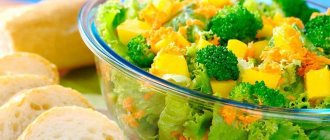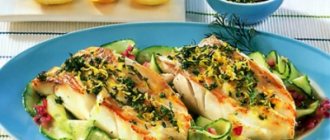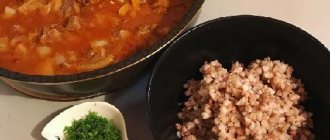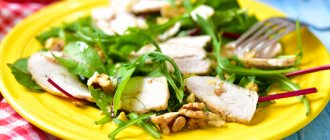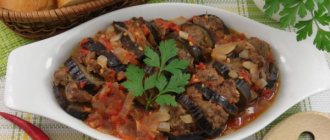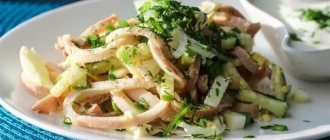What's not allowed?
A hypoallergenic diet completely excludes all food allergens, including:
- meat and fish products (including caviar)
- citrus
- all types of nuts
- red and orange fruits and berries
- melon and pineapple
- spicy vegetables (radish, horseradish, radish);
- chocolate and coffee
- honey, sugar, jam, baked goods and all types of confectionery products
- salted and smoked products
- mayonnaise and ketchup
- juices
- eggs
- mushrooms
- poultry meat (except white meat chicken and turkey)
- cheese
- all industrial products (excluding baby food)
- alcoholic drinks
It is also important to remove from the menu foods to which the patient has individual intolerance.
What is possible?
Most often, the following products are allowed to be included in the hypoallergenic diet menu:
- Meat: boiled beef, white meat chicken and turkey;
- Vegetarian soups made from approved products;
- Vegetable oil: olive, sunflower;
- Porridge: rice, buckwheat, oatmeal;
- Lactic acid products: you can have cottage cheese, yogurt, kefir and yogurt without additives;
- Brine cheese (brynza);
- Vegetables: cucumbers, cabbage, leafy greens, potatoes, green peas;
- Fruits: green apples, preferably baked, pears;
- Tea and dried fruit compote;
- Dried white bread, unleavened flatbread, unleavened (yeast-free) lavash.
Please note that the list of permitted foods, as well as the list of prohibited foods, may vary depending on individual indications, and the final version of the diet should be drawn up by the attending physician.
Entertaining noodles
As practice shows, noodles are also often found among the gastronomic preferences of children. Therefore, a soup with her participation will be a success. First, prepare vegetable broth from foods allowed for your child. This could be potatoes, cauliflower or broccoli, pumpkin, leeks. Meanwhile, boil the noodles according to the usual recipe in salted water with oil, rinse under cold water and transfer to boiling vegetable broth. Add some chopped parsley here and cover the pan with a lid so that the soup is saturated with the aroma of herbs. After which you can serve the dish to the table.
Menu options for the day
Breakfast: wheat porridge, tea, green apple
Lunch: vegetable soup, meatballs, pasta and dried apple compote
Dinner: vinaigrette, tea with a bun
Breakfast: buckwheat porridge, tea, apple
Snack: coffee with milk, cookies
Lunch: Minced chicken soup, boiled beef stroganoff and mashed potatoes, compote
Dinner: curd pudding, jelly
Breakfast: semolina porridge, tea, apple
Snack: Cabbage and carrot salad
Lunch: vegetarian cabbage soup, baked rabbit leg, stewed carrots, compote
Dinner: milk noodles
Bunny's Adventure

You can safely add meat ingredients to hypoallergenic soups for boys and girls. Dietary chicken breast, veal or rabbit will be quite appropriate in such recipes and will appeal to even the most capricious kids. Without any difficulty, boil the rabbit meat (80 g) in salted water, and at the very end add 70 g of broccoli and 60 g of zucchini to the pan. Next, we turn all the components into a homogeneous mass using a blender. If you want a thicker consistency, add some mashed potatoes or watered rice porridge to the soup. Does your child prefer thinner soups? Pour the diluted hypoallergenic milk mixture into it.
Recipes for a hypoallergenic diet
Soy milk soup with potatoes
200 g soy milk
3 potato tubers
Step 1. Peel the potatoes and onions, finely chop them into cubes, add water and cook for 15 minutes.
Step 2. Add milk, salt and cook for another 10 minutes.
Step 3. Pour into plates, sprinkle with parsley and serve
Creamy chicken soup
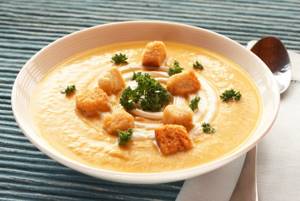
1 liter of meat broth
200 g minced boiled white meat chicken
2 tbsp. l. soy flour
Step 1. Mix a glass of broth and minced meat, add soy flour.
Step 2. Pour in the remaining broth, add salt, and bring to a boil.
Stuffed apples
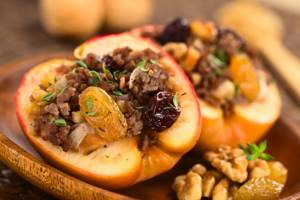
250 g boiled lean beef
3 tbsp. butter
½ cup breadcrumbs
Salt, pepper, nutmeg
Step 1. Preheat the oven to 200 degrees C. Cut the apples into halves and remove the core.
Step 2: Melt the butter in a saucepan. Sauté the onion for 5 minutes until soft. Transfer to another bowl.
Step 3. Pass the beef through a meat grinder and combine it with onions.
Step 4. Add breadcrumbs, basil, nutmeg, salt, pepper, mix.
Step 5. Stuff the apples with this mixture, then place them in a baking dish and pour in 1 cup of broth. Cover with a lid and place in the oven for 35-40 minutes.
Step 6. Transfer the apples to another bowl. They shouldn't get cold. Pour the liquid the apples were cooked in into a saucepan. Keep on medium heat for about 3 minutes.
Step 7. Dissolve starch in cold water. Pour it into a saucepan. Cook until thickened. Serve the stuffed apples with this meat sauce.
Turkey meatballs with zucchini
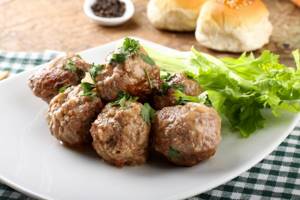
1 turkey breast
Step 1. Grind the zucchini in a blender
Step 2. Grind the turkey meat and punch it together with the zucchini.
Step 3. Boil the rice until half cooked, add to the minced meat, add salt, and add finely chopped herbs.
Step 4. Make small meatball balls. Place them in a baking dish.
Step 5. Bake for half an hour at 180 degrees.
Cottage cheese casserole
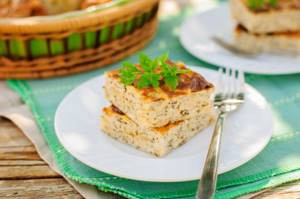
2 tbsp. semolina
Cauliflower to the rescue

How to prepare hypoallergenic soup for a child so that it is not only healthy, but also tasty? The main principle to adhere to is that the fewer ingredients in a dish and the simpler the technology for its preparation, the better for the child. One of the win-win options in this regard is cauliflower. It is very easy to prepare and has a mild neutral taste. Boil several cauliflower florets in salted water and rub them through a sieve. Add 50-60 g of oatmeal to the remaining broth and cook for 10 minutes. Then return the pureed cabbage mass to the pan, add the chicken egg and bring the soup to a boil. Pour in milk based on a hypoallergenic mixture (80 g), add salt and add a piece of butter - a delicious cauliflower soup is ready.
Weekly menu for a child with allergies
Comments on the menu from pediatrician, dermatologist Anna Bolshakova .
Anna graduated from the Pirogov Russian State Medical University with a degree in pediatrics. She received her postgraduate education at the Department of Dermatovenereology, Faculty of Pediatrics.
For more than 4 years, she has been helping online children become healthy and mothers become beautiful.
During this time, she conducted more than 1000 hours of online consultations, more than 50 trainings and online programs for children’s health (including creating an Online Allergy School for Moms, which has already helped hundreds of children around the world go into remission).
Basic principles of creating a menu for allergy sufferers
Up to 3 years of age, one of the main reasons for the development of allergic reactions in children is food. This is partly due to the intolerance of certain foods by a small organism, and partly to the immaturity of the digestive system.
With age, the influence of food allergens decreases somewhat (household allergens take the leading positions), but even an adult with allergies should carefully consider their own menu.
What is important to pay attention to when creating a menu for an allergy sufferer:
- It is necessary to find out (by keeping a food diary up to 3 years and specialized tests for allergens after 3-4 years) which foods cause allergic reactions, and try to avoid eating them.
- It is advisable to significantly limit in the diet such foods that provoke allergic reactions such as cow's milk, chicken eggs, chicken (note!! chicken is the strongest allergen!), nuts, in particular peanuts, wheat (meaning gluten, which is contained in wheat), fish, shellfish, soy, chocolate and citrus fruits.
- When creating a menu, be guided by the degree of activity of the allergic process: during remission (that is, the state of “external health”), an allergy sufferer can afford to expand the diet with low-allergenic and moderately allergenic products.
- Since in 80% of cases, allergy sufferers experience concomitant disturbances in the functioning of the digestive system, it is important to follow the principles of a healthy diet, excluding smoked foods and limiting fried foods in the diet.
- Also, when preparing first courses, do not use meat broth, replacing it with water or a decoction of vegetables, to which the child does not react.
- By allowing small “variations” in your diet once a day, try to make the rest of your meals as hypoallergenic as possible!
- When choosing sweet dishes for an allergic person, try to “play up” the fruits that are allowed for him to eat: the fact is that when preparing most desserts, highly allergenic foods are used, which can be allowed in minimal quantities only during remission of the disease.
Yes, creating a universal menu for a child with allergies that would suit everyone is quite difficult. I will give an example of a menu, explaining my choice in the comments:
MONDAY

Afternoon snack: cottage cheese balls in a slow cooker (without sauce, egg - carefully)
A comment:
Try to “modify” recipes “to suit yourself”: replace broths that are dangerous for allergy sufferers with vegetable broths or just water. Recipes “with sauce” can always be prepared without sauce, which most often contains spices (a fairly strong allergen). If a child is allergic to eggs, choose recipes with a minimum amount of them and be sure to look at the skin reaction: not every allergic person who reacts to eggs “in their pure form” will react to it in a dish. Also choose safer cooking options: steaming or stewing.
Koloboks in broth

All kinds of light vegetable broths are another very good solution that your child will like. You just need to make a small intriguing addition to them. Boil regular rice (100 g) in salted water, flavor it with a piece of butter and add a chicken egg. When the rice mass has cooled, we form miniature balls out of it, roll in flour and cook in salted water until cooked. Then put the resulting rice dumplings on a plate and fill them with vegetable broth. Write a funny story about them, and your child will definitely start eating the wonderful koloboks with gusto.
TUESDAY

Lunch – potato soup (without green peas)
Afternoon snack: cottage cheese balls in a slow cooker (without sauce, egg - carefully)
A comment:
Legumes often increase gas formation, which can provoke an exacerbation - choose recipes without them (or use them sparingly). Dishes made from fermented milk products usually cause fewer reactions than using whole milk (if you are allergic to it), but always focus on your child and his characteristics!
WEDNESDAY

Breakfast: oatmeal porridge with apples (apples are best in the microwave with sugar, without milk, be careful - gluten)
Lunch – potato soup (without green peas)
A comment:
Apples will turn out no less tasty, but safer when cooked in a slow cooker or microwave. Oatmeal contains gluten, which means it is excluded if you are allergic to it! Also be careful with milk cereals if you have reactions to milk! The most hypoallergenic types of meat: beef, turkey, rabbit - choose them when preparing lunches. Carrots are a fairly strong allergen, but when consumed in small quantities they may not cause a reaction (boiled carrots are also safer).
THURSDAY

Breakfast: “Assorted” porridge (caution if you are allergic to gluten and milk!)
Lunch: zucchini soup (without curry or broth)
A comment:
Curry (like other exotic seasonings) is a strong allergen. When making dishes for people with allergies, limit their use as much as possible.
Soup for allergy sufferers - Recipes for allergy sufferers
7984
To prepare any dish for a child or adult with allergies, the main thing is to follow several rules.
Firstly, all products must be of high quality. They must be fresh: vegetables not rotten, products without traces of mold. If the stomach of a healthy person can digest such products, then for allergy sufferers this will cause a deterioration in the condition and possibly an increase in the products to which an allergy occurs.
Secondly, no dyes or preservatives. Many E themselves cause allergies. And some of them are strengthened by what already exists. So you need to read the composition from the first to the last letter.
Third rule: nothing spicy, salty, fried or sweet. All this can greatly intensify the manifestations of allergies and add new ones. Everything should be steamed, boiled or baked.
The fourth thing to remember is the ban on adding highly allergenic foods to food. This list includes: - fish and seafood - milk and milk-containing products - exotic fruits - soy products - citrus fruits - chocolate, cocoa - eggs - nuts - strawberries, raspberries This list is excluded immediately. And then they select products depending on individual allergies.
And so we got directly to the soups.
What are the features here:
- If you cook soup with meat, be sure to drain the first broth! - Choose meat according to the degree of allergy: turkey, beef, rabbit, chicken, pork. In addition, take fillet meat without fat and without skin, preferably breast. — It is better to start preparing soups for a child with 1 product, then try the second (after a week or two, and only then combine them. To add a third product, you also need to try it for several days and only then, making sure that the allergy does not manifest itself introduce, can be added to our soup. - The following vegetables are usually added to soup for allergy sufferers: zucchini, broccoli, cauliflower, green beans, white beans, green peas, potatoes, zucchini, regular cabbage. After you have mastered these products, you can try to introduce and colored vegetables: carrots, pumpkin, red beans and beets. - In addition to vegetables and meat, cereals are also added to soups. Here it is better to opt for rice and durum noodles. - It is better to take dill as a seasoning. It almost never causes allergies. In addition, it will have a beneficial effect on the stomach.
Here are some soup recipes for allergy sufferers.
— turkey meatball soup — chicken noodle soup — green bean soup — broccoli and cauliflower puree soup — borscht for allergy sufferers — pureed zucchini soup — pumpkin soup with beef
Recipes for allergy sufferers: “Soup for allergy sufferers”
If you found this information useful, please share it on social networks.
This will serve as an additional motivator, an incentive for further publications on alergino.ru of articles on topics that interest you. 02/01/2016 Admin
Related on the topic
SUNDAY
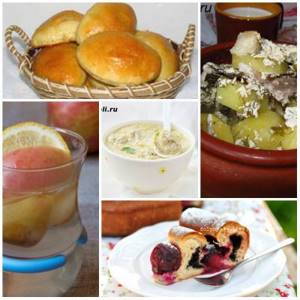
Dinner: skrylki (lean pork in half with beef)
A comment:
In recipes where you cannot completely replace fatty meats with hypoallergenic ones, try to at least reduce the “concentration” of pork or lamb. Apple compote is the best choice for drinking for allergy sufferers (much safer than juices, fruit drinks and jelly).
The menu was compiled taking into account the principles of the “Menu of the Week” system.
So, as you can see: if you get creative in creating a menu for a little allergy sufferer, then it is quite possible to feed him fully! Being the mother of a child with allergies is very responsible, but if you and your baby are a team, you will definitely defeat this insidious allergy!
